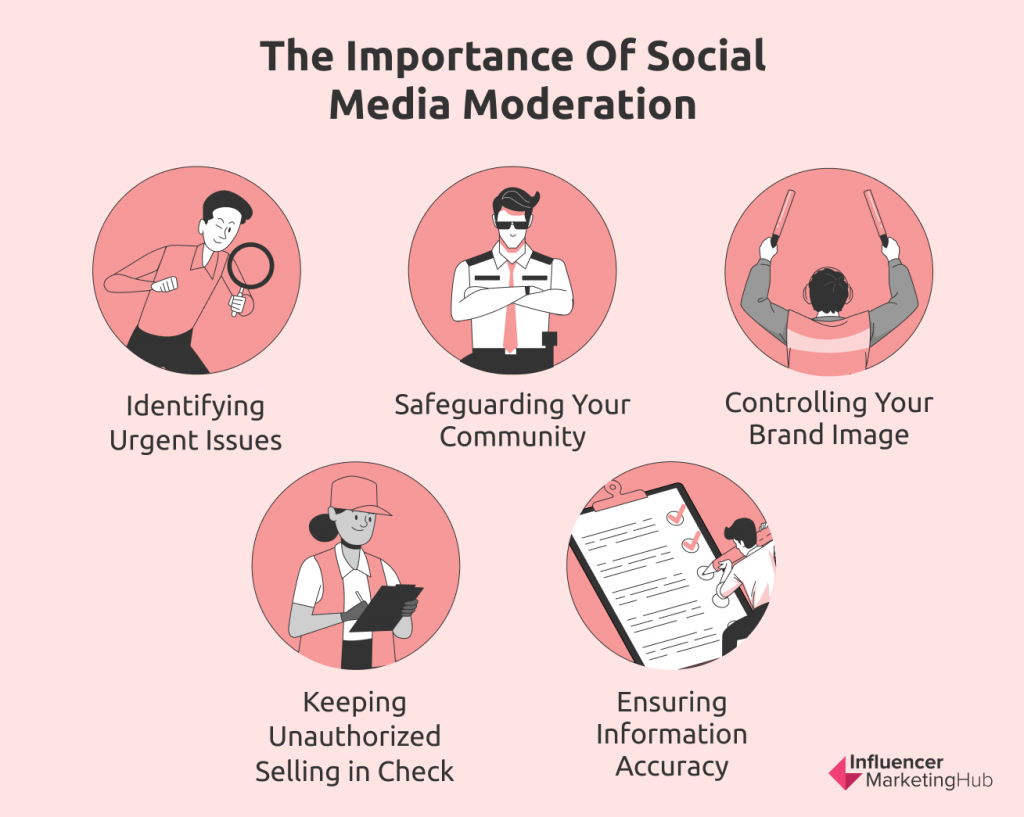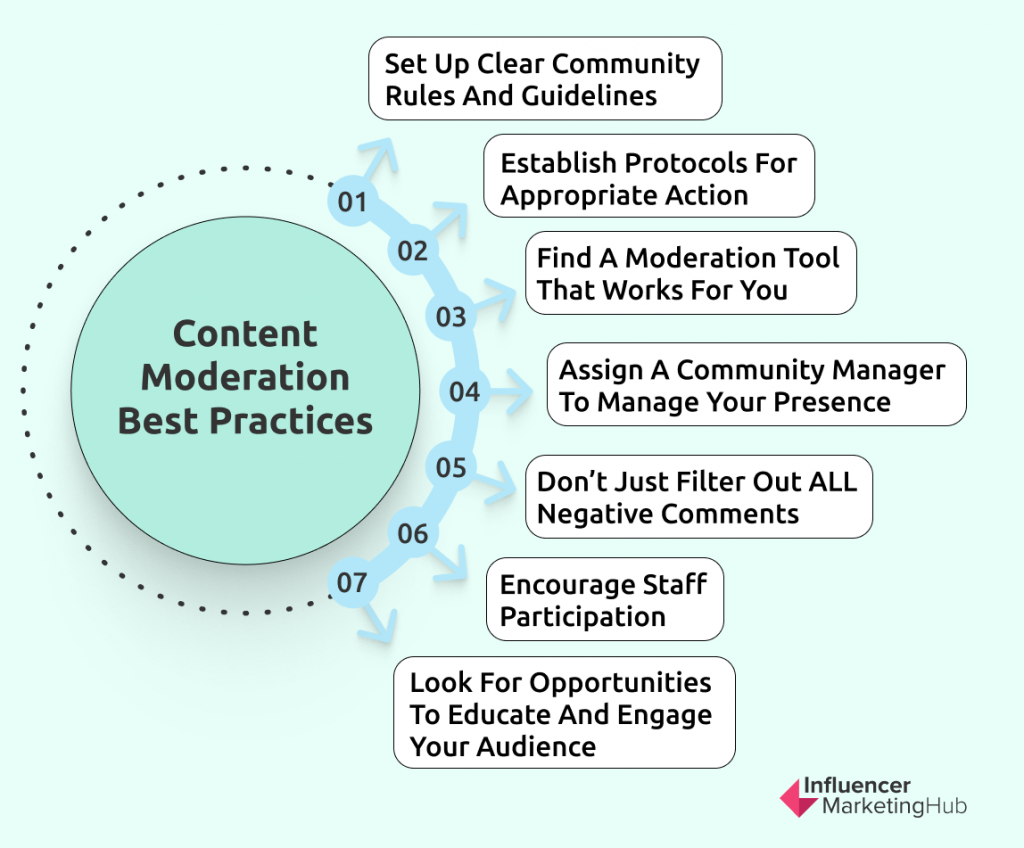对于在社交媒体上建立了业务的品牌而言,这一存在可能是重中之重。但是,同样重要的是保持一致的图像,并确保您不会失去自己努力构建的存在。这就是为什么在线内容审核至关重要的原因,因为您品牌社交媒体页面上的活动可能会产生影响。
But what is content moderation really? And what is its purpose in the context of social media? In this guide, we provide you with an in-depth look at what content moderation is and how to carry it out on social media. Let’s dive in.
What is Content Moderation? Ultimate Guide for Social Media Moderation in 2022:
What Is Content Moderation?
Content moderation is the process of monitoring whether content submitted to a website complies with the site’s rules and guidelines and is suitable to appear on the site. It involves setting rules and guidelines that all content appearing on the site must abide by and filtering out anything that’s deemed harmful, sensitive, or inappropriate.
Essentially, content moderation helps to ensure that the content published on the site is not illegal, inappropriate, harassing, or harmful to others. It’s commonly used in websites that rely heavily on content generated by users such as forums, social media platforms, dating sites, and online marketplaces.
What Is Content Moderation for Social Media?
在社交媒体的背景下,内容审核是审查和管理的过程用户生成内容on your brand’s social media page. Also called social media moderation, this could involve responding to comments made by users or sometimes reporting or removing posts and comments if they don’t comply with your brand’s guidelines.
The Importance of Social Media Moderation
Social media content moderation is crucial for brands that want to maintain a consistent image and create a safe online community for their audience. There are a number of reasons why content moderation should be a top priority in your brand’ssocial media strategy.

Identifying Urgent Issues
Whether it’s a typo in your caption or a broken link in your ad, social media users are quick to point out issues that need immediate fixing. Moreover, spikes in negative comments could also reveal bigger issues related to your brand and/or its products. Moderating comments is a great way to identify urgent issues and resolve them before things escalate.
Safeguarding Your Community
建立了一个由忠实的粉丝和追随者组成的社交媒体社区后,您将要尽一切努力保护社区。这可能来自公然的有害行为,例如仇恨言论和歧视性语言,也可以来自垃圾邮件和骗局。
诈骗者可能正在为可能正在寻找交易和折扣的脆弱人士提供评论部分。或者他们可以评论赚钱或解决某个问题的快速方法,例如在下面的示例中。
They could then target them by asking for personally identifiable information, which could then be used maliciously. Content moderation helps you detect these harmful or hateful comments and manage them effectively.
Controlling Your Brand Image
The comments on your brand’s social media page are a reflection of your品牌形象. So whether you agree with it or not, permitting hate speech or discriminatory language in your comments section reflects poorly on your brand. People are going to associate your brand with those comments, which means that your brand image could be permanently scathed.
此外,关于您的品牌的负面评论也反映出您的品牌,尤其是当这些评论指出相同的问题时,例如未送达订单或无反应的客户支持团队。像以下情况这样的情况在于客户同意另一个客户的负面评论,可能会给许多潜在客户和现有客户留下不好的印象。
Keeping Unauthorized Selling in Check
Large brands may often fall victim to counterfeiting and unauthorized reselling. And counterfeiters and unauthorized resellers could use your social media comments section to find potential buyers. Moderating your comments is crucial to keep those attempts in check and ensure that you don’t lose out on sales to competitors.
确保Information Accuracy
Your brand’s comment section could also invite trolls and malicious users who want to spread false information about your products or service. Moreover, you may also get comments on inaccurate information regarding your products or service such as the ingredients used or how they should be used.
Whether these users mean actual harm to your brand or simply want to troll, they could create a negative brand perception. In some cases, they could even cause actual harm to community members who follow their advice. So it’s crucial that you moderate these types of comments closely so that your community only gets access to accurate information.
Human Moderation vs. Automated Moderation
在为其社交媒体页面设置内容审核系统时,品牌通常必须在两个选项之间权衡两种选项 - 人类或手动审核和自动节制。通过手动审核,人类主持人屏幕屏幕并管理您的社交媒体页面上的评论,以确保它们与您的社区准则保持一致。尽管这确保每个评论都会经过适当的审查,但可能会很耗时。
因此,人类节制可能只适用于仅在其帖子上看到一些评论的小型企业。当评论和对话开始逐渐建立时,品牌将需要掌握这些活动的顶部,以确保没有有害的评论在裂缝中落下。他们需要几乎实时地这样做,以便有问题的内容没有时间损害其社区或品牌声誉。
Automated moderation using content moderation tools has become the ideal option. The tool automatically screens each comment that’s submitted to your social media page and either approves or rejects it. This significantly speeds up the process of reviewing and managing comments and posts on your social media pages.
In some cases, the comments are also sent to a human moderator for additional review. This extra step is important when the tool can’t understand the nuances in the comment to assess whether it complies with the brand’s community guidelines.
Certainsocial media management platformslikeSendiblealso come with built-in content moderation features for Facebook. This allows you to specify words or phrases that go against your community guidelines so the tool can automatically remove posts or comments containing those specified keywords.

资源:sendible.com
Content Moderation Best Practices
Now that you know exactly what content moderation is and why you need it for your social media page, it’s time to start using it for your brand. Here are a few best practices to follow so you can successfullymoderate user-generated content在您品牌的社交媒体上。

Set Up Clear Community Rules and Guidelines
首先定义规则和准则是什么,以便您的受众确切知道要为社区创建的环境。这可能在不同的品牌和社交媒体社区中有所不同。尽管某些品牌可能允许发誓(尤其是在积极的环境中使用时),但其他品牌可能不会那么宽大。同时,所有品牌都可以同意禁止冒犯性和歧视性语言。
Look at who your followers are, what your品牌个性is, and what type of content you have on your page to get a better idea of what those rules and guidelines might be. Having these rules and guidelines laid out is essential for determining your moderation methods and establishing a baseline for your actions.
Additionally, you may want to publish these rules and guidelines for your audience to see. This helps ensure better transparency and clears up any confusion about what types of content are not allowed on your page. On Facebook, you can add this info in the “Details” section of your page. On visual platforms like Instagram, you may need to publish them in the form of an image.
Tourism Australia clearly outlines the types of posts that will not be tolerated on their Facebook page. As you can see, there are plenty of rules and guidelines for their community to follow.

资源:facebook.com
Establish Protocols for Appropriate Action
Once your rules and guidelines are established, you also need well-defined protocols on what actions to take when you come across content that violates those rules. This will bring clarity to the backend team on what warrants removal and what needs to be reported. It will also give you direction on how to effectively set up your moderation tool.
The protocol should define what types of comments should be removed or rejected. It should also define what types of comments should be kept but responded to and how the responses should be constructed. Additionally, even if you have an automated moderation tool set up, you should specify when certain comments should be passed on to a human moderator.
It’s also important to delegate moderation tasks to specific people. Who is responsible for responding to the comments? Who should look into the issues raised by customers in the comments? Make sure your team members know exactly who is in charge of what so they can make an organized effort at efficientlymanaging your social media.
In the Tourism Australia example above, the page also specifies what action will be taken when users violate the guidelines. They specify that such comments will be removed and users violating the policy will be blocked from following Tourism Australia’s social media profiles. Additionally, in extreme cases, the page may even report the user to relevant authorities.

资源:facebook.com
找到一个适合你的适度的工具
与自动审核的工作asier, investing in a social media moderation tool is a must. If you’re already using a social media management tool, see if it comes with built-in content moderation features. Otherwise, you’ll have to find a tool that comes with moderation capabilities for all the social media platforms relevant to your brand.
Additionally, content moderation tools come with varying levels of moderation and different features. You’ll need to compare your options to find something that fits your moderation methods and preferences. For example, some tools may come with robustsentiment analysisfeatures to assist your moderation efforts. You may also find tools that automatically scan for and remove inappropriate hashtags and handles in addition to words.
Assign a Community Manager to Manage Your Presence
Next, it’s time to assign a community manager to help you manage your online presence. Although you may rely heavily on a tool to automate your social media moderation, tools can’t fully replace humans. A community manager may be able to understand the nuances in a comment that an automated tool might miss. For example, a sarcastic comment about your service may be mistakenly approved by the moderation tool because of the positive words it contains.
As such, a community manager ensures that the comments and posts on your social media page align with your brand’s image. They help to maintain a certain level of quality in the standard of conversations on your page so that brand perception remains positive.
此外,当客户需要更详细的响应时,拥有社区经理会提供帮助,这些响应不仅仅是将其引用到您的帮助页面。尽管您可以自由地忽略这些评论或提供副本的响应,但如果您想建立一个强大而敬业的社区,那将做得太多。例如,Canva向某人提供了一个详细的答案,询问他们如何像品牌在推文中一样产生颗粒状效果。

资源:twitter.com
Don’t Just Filter Out ALL Negative Comments
It may be instinctual to ban or remove every negative comment your brand receives, but this could sometimes do more harm than good. While it may seem counterintuitive to let negative comments remain on your page, those comments could prove to be an asset for your brand with the right response protocol in place.
The goal is to respond appropriately to those negative comments to maintain transparency andwin the trust of your community. Think about whether your audience would trust your brand if they notice that you’re removing every single negative comment. On the contrary, if they can see that you’re trying to resolve customer complaints or clarify any confusion, it could show them that you’re not trying to hide anything and that you’re genuinely helping.
Have a protocol in place for how to deal with different types of negative comments. While hateful and derogatory comments may be due for immediate removal, you may want to keep negative comments that are trying to spread false information or complaining about your products. Your community manager could then respond to those comments with clarifications or resolutions depending on the situation.
Additionally, you’d definitely want to keep comments that point out a mistake. Show your community that you own up to your mistakes and try to fix them promptly. See the following interaction in which a follower points out a typo in a Facebook post from Able, a New Zealand-based non-profit organization. The organization promptly fixes the typo and thanks the follower for pointing out their mistake.

资源:facebook.com
鼓励员工参与
Depending on the nature of your business, you could also have your staff set the tone for the type of conversations you want on your social media pages. Seeing your staff start the conversation with entertaining and relevant comments could give people some direction on what types of comments they should leave. This is an effective way to minimize the need for moderation because most people will try to maintain the standard of conversation that’s been set.
Additionally, your staff could also provide informed answers to people who have doubts or questions in the comments. This helps keep things personal while helping you save tons of time in keeping on top of all those conversations.
Look for Opportunities to Educate and Engage Your Audience
Your comment section could be a goldmine for community engagement with people asking questions and looking for help. Make sure you’re actively trying to surface those comments and turn them into something valuable for your brand.
For example, someone could ask a question about the ingredients you use or the sustainability goals you have. Answering those questions helps to not only educate the original commenter but also others who chance upon your conversation.
请参阅以下对话,客户询问Everlane是否使用纯素皮革。在看到该品牌的解释后,另一个客户也参加了对话,并分享了他们对寻找素食皮革选择的兴奋。
Weaving Moderation into Your Strategy
With the right tools and protocols set up, social media content moderation is easy for any brand. Make the most of the ideas and tips given above to incorporate content moderation into your social media strategy.
Frequently Asked Questions
How do you do social media moderation?
您可以通过设置遵循规则和指南以及使用协议来进行社交媒体审核。然后根据这些准则,使用自动化工具与人类适度结合使用这些准则开始调节。
What is social media content moderation?
Social media content moderation is the process of reviewing the comments and posts that people share on your social media page to make sure that they abide by your community rules and guidelines.
What are social media moderation tools?
Social media moderation tools are tools that help to scan user-generated content and automatically remove or flag ones that violate the community rules and guidelines.
What are the types of moderation?
Pre-moderation, post-moderation, reactive moderation, and distributed moderation are some of the main types of moderation.
How do you plan and prepare for moderation?
您可以通过制定明确的规则和准则来计划和准备审核,并建立协议以处理任何违反该规则的行为。




